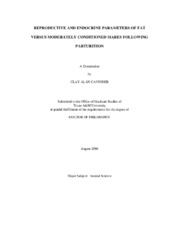| dc.description.abstract | An increase in time to ovulation following parturition could result in economic loss if the mare cannot successfully conceive within a short time after foaling. To evaluate if a difference exists in reproductive efficiency of fat- (body condition score of 7 to 8) versus moderately-conditioned (body condition score of 5 to 6), 24 mares were allotted to and maintained in their respective group from late gestation until pregnancy was confirmed following breeding on the second post-partum estrus. Days to ovulation, interovulatory intervals, conception rates, and endocrine profiles were analyzed. Serum concentrations of thyroxine (T4), insulin-like growth factor-1 (IGF-1) and leptin were assayed in order to characterize normal circulating blood concentrations. There were no differences (P>0.05) in mean interval from parturition to first ovulation (14.41 ± 1.07 and 16.18 ± 1.06 d), first to second postpartum ovulation (22.91 ± 1.07 and 24.33 ± 0.93 d), or in conception rates (91.67% and 83.33%) between the 2 groups. However, mares in moderate conditioning did lose a greater percentage of body fat upon foaling as compared to fleshier mares (0.82% versus 0.35%). Leptin concentrations were not different between the groups (P>0.05). Nevertheless, serum concentrations of T4 were higher (P<0.01) and IGF-1 concentrations lower (P<0.01) in moderate- as compared to fat-conditioned mares during times of ovulation and the interovulatory period. Results indicate that mares maintained in a fleshy body condition are not prone to reproductive dysfunction or lowered levels of fertility. The significance of the current results is important as it reassures the breeder that mares in a fatter body condition score (BCS of 7-8) should not demonstrate sub-fertility related to level of body fat. Additionally, results indicate that mares may need to be kept in a BCS of 6 in order to avoid losing enough weight upon parturition and early lactation to bring the BCS below 5. It suggests that varying amounts of circulating T4 and IGF-1 do not affect reproductive capabilities of mares in a BCS of greater than 5 following parturition. | en |


